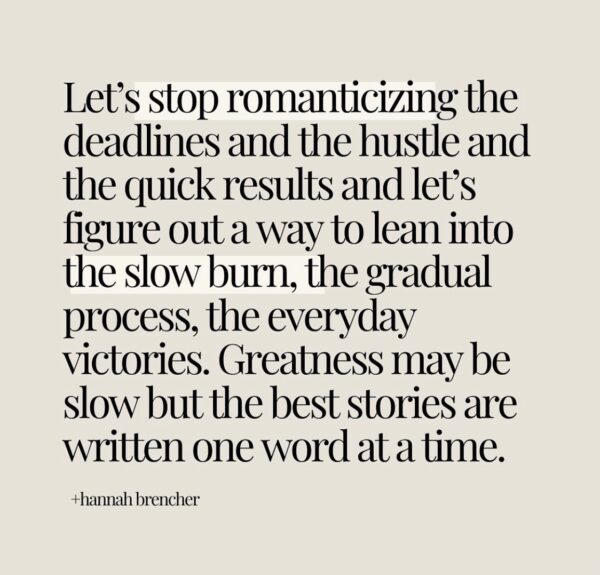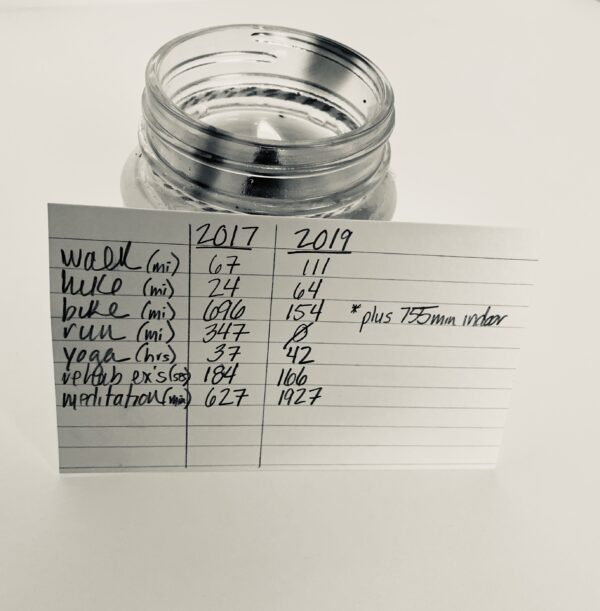Once upon a time, the only thing people knew to ask me about was what race I was training for. Between running and triathlon, there was always something on the calendar. No matter the weather or the state of my body and mind, I NEVER forfeited an entry fee. Even if it meant literally or proverbially limping across the finish line.
This was not sustainable, nor productive.

So in my early 40’s I set out to define Sustainably Productive fitness for myself. This is how the idea of Fitness without a Finish Line was born.
Step One – Identify What Isn’t Working
The first step was to identify what was not working for me. This fell into two main areas.
How I exercised. I was always trying to go faster or longer. When I finished an Olympic distance tri, I had to go for half Ironman distance. I knew I would never win so I had to try to impress people with the distances I was able to go. Even if “able” meant nerve pain sending streaks of pain through my foot or chronic headaches after every swim.
I also stuck to the schedule NO MATTER WHAT. I biked in storms, barely able to find old barns for shelter from lightning. I ran across icy roads barely able to keep from sliding. I swam in lakes in early morning dark hours when I could only hear (not see) the nearest person to me (I keep telling myself it was a person I was hearing).
I am lucky to have come out the other side of such poor choices as unscathed as I have.
Why I exercised. The short story is I needed approval (the long story is for my therapist). Whether it was wows over the distances or societal approval over my appearance, I exercised hard to bring in all the gold stars.
Running burns lots of calories quickly so I stuck to races that incorporated some kind of running. Even though I have exercised-induced asthma, I would run through colds, often pushing them over the edge into bronchitis – just so I could maximize the energy expenditure.
There were several tipping points to bring about my need for change. Once I identified that I needed to make some changes, I started with small adjustments.
Step Two – Make Small Adjustments
Don’t throw the baby out with the bath water. SusPro methodology identifies value in what you are doing and encourages doing more of what works while you make adjustments in what is not working. Here are a few adjustments that I made.
- Racing sabbatical – no race entries for 6 months to see how it felt. The weirdest thing was that I did not have any quick conversation topics. Needless to say, this felt like a whole different problem that what we are talking about today. By calling it a sabbatical, I did not have to dramatically declare that I was never going to race again. I was just trying on this non-racing identity to see how it felt. Spoiler: I have not entered a race in about 5 years.
- Increased emphasis on pre-hab. Instead of waiting for injury to strike and cause another round of physical therapy rehab, I now have a pre-hab PT routine that helps to prevent those injuries. I added in some body weight exercises to boost my bone density where I can. Over the course of about 6 months I have gradually increased my pushups and can now do 100 military pushups in a day’s worth of strength training / pre-hab.
- Challenging yoga. My yoga studio closed during COVID forcing me to find another hot home for yoga. Never in a million years did I think I would land in power yoga classes in a hot studio. This is power yoga in 95-100 degree rooms. And I love it. This is for sure a COVID silver lining.
Step Three – Evaluate Progress
I track various fitness components in a spreadsheet. Here is a sneak peek from yesteryear (2018 I had knee surgery so the whole year was a bit of an outlier). Some days it feels useless to mark that I walked 1 mile, but over several months, it sure adds up.
And to be able to look back over YEARS is also pretty cool! Don’t try to recreate the past – just start today. You can download the Sustainable You Habit Tracker here for free!

As you are evaluating this progress, you just return to step 1 and evaluate what is not working and make more adjustments. You might have different seasons where schedules, weather, and interests impact your exercise routine. That is ok as long as you keep going. Be heartened that there is no finish line. You are never last, you can never fail as long as you keep trying.
Your Turn
Tell me about your exercise routine, choices, fears, and habits!
Leave A Comment